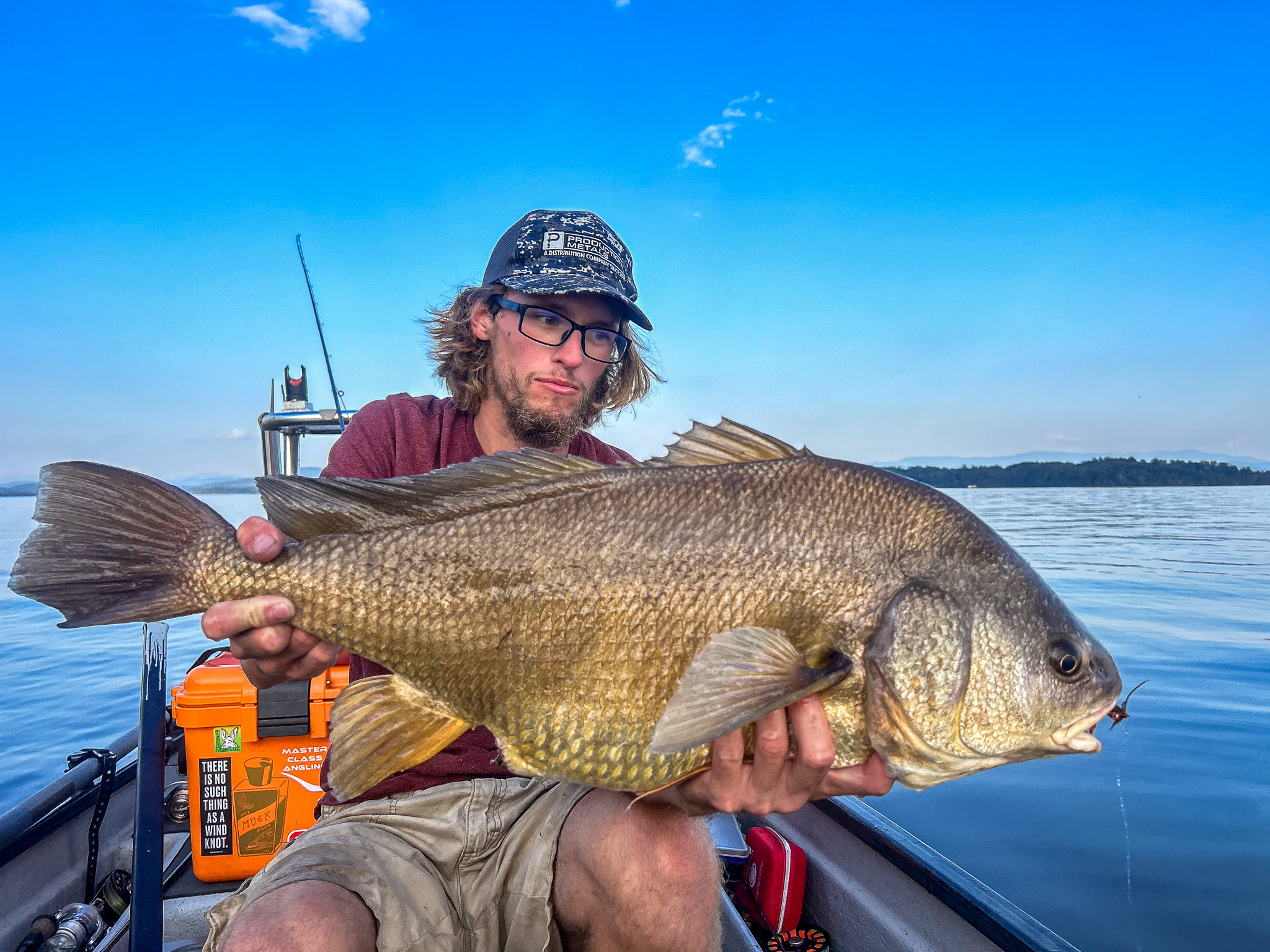Freshwater Drum — a.k.a. sheepshead — exist in lakes, rivers, and streams across a large portion of the U.S. They can weigh more than 20 pounds and they fight with the same bulldog energy as their salty cousins. Still, not many people seem to care. For most anglers, drum are a nuisance bycatch that waste worms and cut baits intended for catfish and hit tubes and crawler harnesses aimed at smallmouths and walleyes. The biggest reason drum get the cold shoulder? They’re not great on the plate—or are they?
Much like lake trout, saltwater sheepshead, and rock bass, their food value wavers by region and angler opinion. I’ve had people swear to me you can’t tell the difference between fillets from a small drum and walleye, and others say it tastes worse than carp (or at least they assume). But let’s set edibility aside for a second and look at the benefits of these brutes as sportfish.
My friend and guide, Drew Price, runs many dedicated drum trips on Lake Champlain each season and spends a lot of his personal fishing time getting after them. Why? Because they’re reliable and pull a heck of a lot harder than bass and trout. Unlike carp, about which the same claim can be made, drum eagerly bite a variety of lures, flies, and baits. Price loves chasing them in the late summer when other fish are sluggish, and by turning bycatch into the target, he’s changed a lot of perspectives on the lowly sheepshead. If you’re ready to change your attitude about them, too, here’s his program.
Listen to this week’s episode of Quick Strike on Apple, Spotify, or wherever you get your podcasts.
Jig the Drum Slowly
Just like saltwater drum, freshwater drum are designed to feed off the bottom or higher in the water column. This adaptation means they’re as good at snatching moving baitfish as they are rooting around for freshwater mussels and aquatic insects. In deeper bodies of water, drum also school up, making them easy to find with sonar. This is what Price wants to see for the fastest action, and when he finds the pile, his go-to lure is a largely overlooked classic.
“My favorite is a Berkley Vibrato, which is just a modern blade bait,” Price says. “Classics like the Cicada work very well, too, and you don’t need a heavy one. I tend to find drum in water anywhere from 10 to 25 feet deep. What I’ll do is drop the lure straight to the bottom, give it a few hard rips to get it vibrating, and then reel it about six inches off the bottom and keep it still. The hit usually comes while the bait isn’t moving. If I don’t get hit after a few seconds, I’ll drop it back down and repeat the process.”
Price points out that drum have rather poor eyesight. While blade baits in staples like silver and gold work well, he leans on brightly colored models more often to create better contrast in deeper water. Bottom line? Feeling the lure isn’t enough. Drum have to see it to attack.
The Fly Beat
It’s fair to say that more people in this country target carp and gar with a fly rod than drum. The truth is drum will bite much faster than both, and fly selection is far less complicated. The tricky part is finding them in the right scenario. It’s true that drum spend a lot of time in deeper water, but not all of it. And, even if you don’t find them shallow, Price has a trick for that.
“I mostly use Clouser Minnows or a similar style of fly,” says Price. “One of my favorite color combinations when I tie them for drum is black and hot orange. You might think I’d need sinking lines to present them, but I actually use floating line and target them along shallower sand and rock bars that taper off into deeper water. Even shallower rock piles can be good because these fish will come into these areas and cruise around looking for food.”
Most fly missions involve blind casting and hoping to get in front of a rooting drum, though in clear water sight fishing is also a possibility. Price also targets them in deeper water by switching to a longer, thinner leader and adding a tungsten drop-shot weight to the nose of his fly. With this setup, he can target fish feeding on the bottom in up to 10 feet of water very effectively.
The Final Craw
Price very rarely relies on live or cut bait for anything. His preference is artificial. While it’s widely known that drum will slurp down anything from a nightcrawler to a chunk of shad, Price likes to remind people that drum are built to eat hard foods like zebra mussels and stonefly nymphs. That said, he believes there’s no better bait for them than a live crayfish.
“The crayfish is king,” says Price. “Drum have an outer jaw and an inner jaw, and that inner jaw is designed to crush things. Even if they’re focused on a different forage on the bottom, if they kick a crayfish out of the rocks, they’re going to hammer it.”
Of course, securing these drum candies can be challenging. Fewer bait shops stock live crayfish these days, which means catching your own supply. Doing so from the same body of water you’re fishing is one thing, but before catching them in a creek to take to the lake, check your state’s regulations on transporting crayfish from one body of water to another. If you’re in the clear, though, Price says in an area with lots of drum, that supply won’t last long.
Read the full article here





